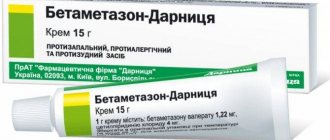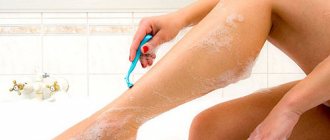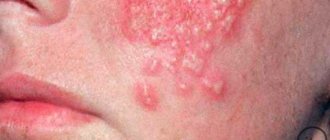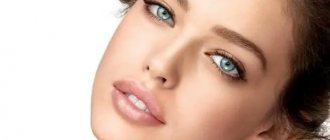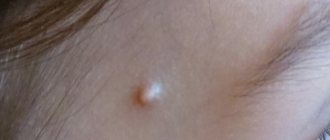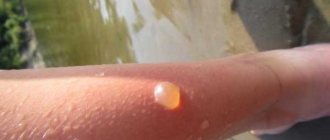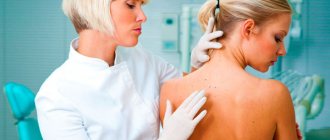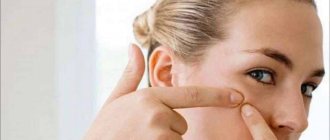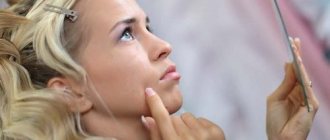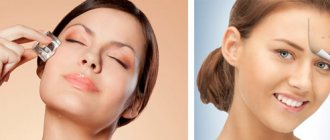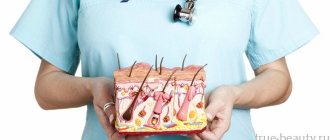Why does a rash appear on the face after childbirth?
Often the cause of rashes in the postpartum period is a jump in hormone levels in the body. During pregnancy, progesterone was actively produced, and when the baby is born, this hormone becomes much less. As a result, there are abnormalities in the functioning of the sebaceous glands, dry skin, and age spots. Also, postpartum acne can be caused by one of the following reasons:
- after childbirth, the mother neglects skin care;
- allergies due to poor nutrition (can occur if a woman is too fond of flour and sweets);
- decreased blood microcirculation due to the fact that mommy moves little and rarely walks outside;
- increased sweating (usually due to significant weight gain after childbirth).
Hormonal fluctuations
There can be various reasons for the appearance of a rash on the body after childbirth, but almost all of them are related to the hormonal activity of the woman’s body.
While carrying a child, the pregnant woman's hormone levels were constantly changing. Childbirth causes a powerful hormonal surge, after which new hormonal adjustments occur in the body. They depend on the woman’s health and the course of labor, in addition, on whether the young mother intends to breastfeed. The appearance of acne on the body after childbirth is provoked by sharp hormonal fluctuations
Immediately after childbirth, the synthesis of the hormone progesterone and human chorionic gonadotropin stops. Such changes can be compared to a diving plane. Throughout pregnancy, the concentration of these hormones steadily increased, reaching maximum values before childbirth. High levels of hormones were necessary to maintain the pregnancy. After the birth of a child, their levels begin to fall rapidly.
Sharp hormonal fluctuations affect the functioning of the entire body. They affect metabolism, water-salt balance, and the functioning of organs and systems. On average, the female body needs about a month for the hormonal levels to stabilize.
During this period, the young mother develops small pimples. They are localized mainly on the chin, forehead and cheeks. However, sometimes acne is found on the legs, arms and stomach. The elements of the rash look like nodules; they do not itch and do not cause discomfort.
In some cases, it may take longer for hormonal levels to stabilize. The body’s ability to recover depends on the woman’s heredity, her health, the severity of the previous birth, the presence of complications and her emotional state. When organ function returns to normal, the rash will disappear without treatment.
How do acne appear?
Skin is the largest organ of the human body by area. In addition to its protective, respiratory and thermoregulatory functions, it functions as an excretory system. If the main excretory systems (intestines and kidneys) for some reason do not cope with their work, the dermis is included in the process of cleansing the body.
Nature provides for skin pores to open and close regularly. Then all the waste products of the body would come out safely. However, due to the fact that people very rarely expose themselves to temperature changes, the skin performs its function lazily and reluctantly. As a result, toxins, getting stuck in pores that lack tone, provoke inflammation. And toxins that can damage tissue lead to irritation and rashes.
How does a pimple form?
How to treat?
Typically, postpartum rashes disappear after hormonal levels normalize. The restoration of the menstrual cycle will indicate that the body has returned to prenatal normal. Until this point, resorting to medications without consulting a doctor is not only pointless, but also dangerous. If your period returns, but the acne remains, it’s time to start treatment.
During lactation, the use of any medications should be treated with extreme caution and, if possible, treatment should be postponed until the end of the breastfeeding period. Creams based on tetracycline or erythromycin show high effectiveness. In addition, the following will help cope with skin problems:
- cosmetic clay,
- zinc ointment,
- Tsindol remedy,
- salicylic alcohol.
Traditional medicine intended to combat acne during the postpartum period is preferred by many mothers, considering them safer than medications. However, before using traditional recipes, it is better to consult a doctor, especially if the mother or baby is prone to allergies. Popular home remedies:
- Infusion of celandine. 3 tablespoons of dried celandine are poured into a glass of boiling water and left for 50–60 minutes. Moisten a cotton swab in the finished infusion and gently treat pimples.
- Tea tree oil and aloe. This mixture can be applied to the skin as a mask a quarter of an hour before bedtime.
- Aloe compresses. 3-4 leaves of the plant should be cut and placed in the refrigerator (but not in the freezer) and left for 7 days. Then grind the leaves in a meat grinder or cut them with a knife, then crush them to a pasty state in a mortar. Juice forms in the mortar - soak gauze in it and apply to problem areas of the skin. Leave for 20 minutes. After this, without washing, apply the remaining paste to the pimples and leave for another 20 minutes. Now you can wash your face with clean cool water. Repeat the procedure for 5 days in a row.
Proper nutrition must include vitamins. If the season or diet of a nursing mother does not allow you to get all the necessary substances from food, you can ask your doctor to recommend a pharmacy vitamin and mineral complex. Low-fat meat, cereals, green vegetables, fruit drinks, compotes and probiotics will help you feel good and look attractive.
Paying attention to hygiene is imperative. It is better to avoid harsh scrubs. They will be replaced by sea salt peeling (necessarily without fragrances) or rolled oats. It is better to avoid any cosmetic and hygiene products with strong odors. You can only use natural cosmetics and be sure to wash them off at night. If pimples do appear, you should not squeeze them out.
Causes
It is known that after conception, a woman’s level of progesterone, the hormone responsible for maintaining pregnancy, increases. In addition to its main function, it stimulates the sebaceous glands, which often causes acne in expectant mothers.
When a child is born, the hormonal levels gradually return to their previous state. But this process does not always go smoothly and normalization of the skin condition may take more than one month.
There are other unfavorable factors that worsen the skin condition of women who have recently given birth, namely:
- Failure to comply with hygiene rules, insufficient cleansing of the skin. In the first months of a baby's life, many mothers do not have enough time and energy to pay attention to appearance and self-care. Excessive accumulation of fat and epidermal particles on the skin causes acne.
- Heat and sweating. If the postpartum period falls in the summer, overheating can contribute to the proliferation of pathogenic microflora, thereby causing inflammation of the skin and the appearance of acne.
- Poor nutrition. An addiction to starchy, sweet, spicy and fatty foods provokes skin problems, which confirms the need to introduce reasonable restrictions into the diet. Vegetables, fruits and greens help normalize the situation.
- Little physical activity. Due to poor health, superstitions or other factors, a woman may avoid walking for some time after the birth of her baby. This leads to disruption of blood microcirculation in the skin and insufficient oxygen supply.
- Allergic reaction. Intolerance to detergents, powders, cosmetics and certain products is one of the causes of rashes that do not go away until the allergen is detected and eliminated.
- Dysbacteriosis. Sometimes the reason that a woman develops acne after childbirth lies in gastrointestinal problems.
If these factors are excluded, but the young mother is still bothered by the rash, she should be examined by a dermatologist. Taking tests will help rule out serious infectious and fungal diseases.
On the face
The skin of the face, especially the forehead, nose and chin, is most susceptible to acne. The sebaceous glands located in these areas, when they are too active, cause clogging of pores, the appearance of pimples and blackheads.
Home treatment for this problem is aimed at thoroughly cleansing the skin and relieving inflammation. To solve the first problem, you can use gentle exfoliants, such as ground oatmeal and honey.
Harsh scrubs are contraindicated as they can injure the skin and contribute to the spread of inflammation.
Also, to eliminate acne on the face after childbirth, masks made of green and white clay are recommended. They act in several directions at once - they clean and tighten pores, and also disinfect problem areas.
If the rash spreads significantly, it is worth adding a wash with natural decoctions. Suitable for their preparation:
- chamomile;
- series;
- sage;
- plantain;
- calendula;
- St. John's wort.
The face is washed or wiped with it several times a day. In the warm season, washing can be replaced by wiping with ice cubes made from the same decoctions. This procedure not only eliminates inflammation, but also tones the skin, promoting its rejuvenation.
Another recognized and safe remedy is aloe. With its help, after childbirth, acne on the face is eliminated by adding a paste of leaves to masks, as well as using the juice of the plant in its pure form.
To do this, you will need to cut off several fleshy shoots and place them in the refrigerator for a week. Then, the leaves are passed through a meat grinder and the juice is squeezed out of the resulting pulp. It is used as a daily lotion.
Although herbal remedies, unlike pharmaceutical ones, can boast of absolute naturalness, they can provoke allergies. If itching, burning, redness or other undesirable reactions occur, their use should be discontinued.
If acne appears on the face after childbirth and the woman is breastfeeding, then only zinc ointment and pharmacy “talk” are allowed for treating the skin from medical preparations. Other drugs and medicinal cosmetics are used only as prescribed by a doctor.
Causes of acne
Pregnancy, childbirth and lactation change not only a woman’s body, but also internal processes in the body. The digestive, cardiovascular and hormonal systems are restructuring their work.
Against the background of ongoing changes, pimples, pustules, and acne appear on the body and face. Women also often note that their skin becomes dry and flaky after childbirth.
How does childbirth affect the condition of the epidermis:
- Hormonal changes During pregnancy, the level of the hormone progesterone increases in a woman’s body. It keeps skin, nails and hair in good condition. After the baby is born, the level of progesterone and other female hormones (estrogens) decreases. This leads to increased work of the sebaceous glands and clogged pores.
- Changes in the functioning of the digestive tract In the last weeks of pregnancy and in the postpartum period, women often encounter difficulties while going to the toilet. Simply put, constipation is a normal occurrence among new mothers. This is explained by the fact that the growing fetus compresses the intestines. Peristalsis slows down. The body's waste products are retained in the intestines and turn into mucus. In such a situation, the dermis takes on the function of removing waste and toxins.
The appearance of acne in the first days after childbirth due to hormonal changes is normal. This deterioration in skin condition is temporary and will go away in 2-3 weeks. But if you ignore the work of the intestines, the problem is unlikely to solve itself.
Provoking factors
The main reasons that acne appears after childbirth are still due to hormonal changes in the body. At this time, the hormone testosterone is actively produced, which in turn activates the sebaceous glands. This process leads to blockage of the ducts, in which sebum accumulates.
Accumulated waste products in large quantities are an ideal breeding ground for bacteria, especially staphylococci, which begin to actively multiply, causing an inflammatory process in tissues. Therefore, the fact that acne appeared on the face after pregnancy should not be surprising at all.
In addition, during this period, the production of another hormone that is very important for skin health, progesterone, is significantly reduced, which immediately adversely affects the appearance of the protective integument of those who gave birth.
But acne may not always appear due to the riot of hormones; predisposing factors also include:
- insufficient hygiene;
- inappropriate cosmetics;
- poor nutrition;
- excessive hyperhidrosis.
Ignoring the rule of washing your face twice a day and not removing makeup at night leads to clogged pores. This in turn leads to the appearance of an inflammatory process. Further ignoring of rashes leads to the development of acne.
Juvenile acne affects girls and boys
If your face suddenly sprinkles, this may be a signal that the chosen cosmetics or cleanser is not suitable for you. This reaction may be a consequence of the development of an allergic process.
Acne on the face after childbirth can most likely be a consequence of the new mother's poor eating habits. Women who limit themselves in many ways after pregnancy break down and allow themselves everything. As you know, the most cruel enemies of the skin are everything fatty, fried and sweet. By overusing this category of products, the appearance of unexpected guests is possible absolutely anywhere on the body, and this happens almost instantly. The very next day, rashes begin to appear.
Sometimes acne on the back, chin, face and other parts of the body is simply a consequence of metabolic disorders in the body, which often occurs in a woman’s body after the birth of a baby.
But subcutaneous acne can be a consequence of excessive sweating, which can occur along with weight gain, which many women who have given birth suffer from.
Regardless of the reason for which rashes appear, the fight against acne should be carried out in any case, because it can bring not only aesthetic discomfort, but also threatens the development of dermatological diseases.
Why do they arise?
A whole class of progestogen hormones is largely responsible for the normal course of pregnancy and the successful bearing of a child. Their name is precisely derived from the Latin term “gester”, which translates as “gestation”. Progesterone is one of the most prominent representatives of this class. Under its influence, the uterus is prepared for implantation, its contractility decreases (which is important for the prevention of miscarriages), lactation in the mammary glands is inhibited, and so on.
But besides all this, one of the side effects of progesterone is a positive effect on the skin. At high concentrations of this hormone, the blood supply to the skin is activated, the hair structure improves, and more collagen and elastin are produced - the main structural proteins on which the smoothness and elasticity of the skin depends. It is the effect of progesterone that explains the fact that many pregnant women quickly notice how their skin has become prettier and younger.
Unfortunately, this cosmetic effect of progesterone does not last forever. With a normal end of pregnancy, immediately after childbirth, its concentration in the blood begins to decrease. This allows the uterus to contract and return to its normal size, and in the mammary glands, now under the influence of another hormone - prolactin - milk begins to be intensively produced.
But at the same time, this kind of “hormonal support” for the beauty and health of the skin ends. In particular, a decrease in the concentration of progesterone leads to the fact that the fatty secretion secreted by the sebaceous glands becomes denser and thicker. Consequently, sebum can no longer be easily released from the pores, clogs them and provides an excellent environment for the development of pathogenic microorganisms with the formation of inflammatory elements. This is precisely the answer to the question of why acne appears on the cheeks and other parts of the body after childbirth.
Are there other reasons?
Yes, although progesterone plays a decisive role, a number of other provoking factors can also contribute to the appearance of rashes:
1. Quite often, after giving birth, a woman begins to rapidly gain weight. For those who are not used to living in a different weight class, this can pose a problem not only from an aesthetics point of view, but also from a hygiene point of view. Increased body weight is always associated with increased sweat production and rapid skin contamination, especially in the area of natural folds. Therefore, greater attention needs to be paid to hygiene procedures.
2. Another hygienic factor that leads to the appearance of rashes echoes the previous reason - a young mother (especially if this is her first child) may simply not have enough time to take care of herself. What to do if acne breaks out after childbirth, and you don’t have time to wash your face again? There is only one answer - you need to find a break for hygiene! Moreover, simple treatment of the face and body will take little time and you can ask relatives to be with the child at this moment. The importance of this event is not even that it will contribute to the return of your normal appearance, but that the purulent contents of acne include pathogenic microorganisms that can be dangerous for a child.
3. Deterioration of blood supply to the skin. A forced reduction in a woman’s physical activity can lead to such unpleasant consequences. After all, she sits at home with the child almost all day, rarely goes out and spends little time in the fresh air.
4. Dietary disorders. Often after childbirth, the mother develops taste preferences and wishes that are unusual for her. In this aspect, according to neonatologists, you should not follow your own body’s lead. Avoid sweets, baked goods, as well as aggressive foods - smoked foods, pickles, fried and fatty foods. All of them contribute to the appearance of acne. The main place in a young mother's diet should be dairy products, fresh vegetables and fruits (but not allergenic!), dark breads, soups and lean meats. In addition to the positive effect on skin condition, a balanced diet will have a beneficial effect on both breast milk production and the baby’s health.
5. Failure to comply with the drinking regime. Breastfeeding requires increased fluid consumption by the mother's body. And this need is imperative - if there is not enough water for the synthesis of breast milk in the mammary glands, it will be taken from other organs and systems. The skin is one of the first to suffer from such a moisture deficiency. It becomes drier, and therefore much more susceptible to infectious agents. Therefore, when deciding what to do if after giving birth your face is covered with acne, first ask yourself: do you drink at least 2 liters of clean water a day? And if not, be sure to adjust your drinking regime.
6. Psycho-emotional disorders. It is no secret that pregnancy, childbirth, caring for a baby and breastfeeding greatly influence not only the physiology, but also the psyche of a woman. She becomes more labile, more sensitive to previously seemingly insignificant factors. Constant stressful situations, depression, lack of sleep and physical activity - all this worsens skin health and can lead to rashes.
Are the rashes dangerous?
Acne on the body of women that occurs after childbirth is often a harmless rash caused by hormonal changes. They only cause a feeling of aesthetic discomfort and after a certain time they disappear without a trace.
However, if acne occurs on an inflamed area of the skin, is accompanied by itching and copious discharge of pus, you should not delay consulting a doctor.
Where else can rashes appear after childbirth?
In addition to the face, acne can be observed on:
1) back. Acne in this area appears due to metabolic disorders. A rash of significant size, which is accompanied by pain, needs special attention. They often occur due to a malfunction of internal organs. In this case, self-medication is unacceptable;
2) legs. Rash on the legs appears due to hormonal imbalance. Over time, when hormone levels normalize, acne disappears on its own. If no improvement is observed, you should consult a specialist;
3) buttocks. Painful pimples in intimate places often appear in single copies. They ooze pus and itch. Such acne occurs against the background of the development of an inflammatory process. As a treatment, in this case, experts prescribe topical anti-inflammatory drugs and recommend changing synthetic underwear to natural ones;
4) hands. The sources of rashes on the hands are the same as for the appearance of acne on the face.
How to care for your skin after childbirth?
To prevent acne from appearing on the skin after childbirth, you need to take care of it. The strict rhythm of a mother's life often leaves little time to do anything other than take care of the child, especially in the first months. However, you need to make time for simple daily care:
- Allocating more time to sleep is one of the best measures to prevent skin problems;
- eat right - the diet of a nursing mother should be based on the principles of a healthy diet, but if for some reason you had to give up breastfeeding, it is recommended to adhere to the rules: a minimum of tea, coffee, smoked meats, salt, include olive oil, brown rice, avocado in the diet;
- drink a lot of water - at least one and a half liters a day;
- use facial moisturizer;
- Make a face mask at least once every 7 days.
Acne treatment
During pregnancy and after birth, a woman should not use medications that contain antibiotics, steroids and benzene peroxide. These substances can inhibit the development of the child or lead to the combustion of milk during lactation. Among traditional methods of therapy there is a huge list of recipes that will improve the condition of the skin and eliminate acne. Masks and compresses with cucumber juice, honey and cinnamon, as well as spot applications of celandine, have proven themselves better than others.
Depending on the location of the rash, traditional healers recommend using various treatment methods. The fact is that in different areas, the skin has a different structure and density, on the face it has increased fat content, on the buttocks and legs it is thinner and more delicate, and on the back, on the contrary, it is dense and porous. Products that are used to treat acne on the face are not suitable for eliminating acne on the back or buttocks.
In the fight against acne on the face during the postpartum period, you should not use scrubs and peels with abrasive particles, they violate the integrity of the skin and further injure it. You should also not get carried away with medications, especially if the woman is still breastfeeding. Medicines can negatively affect the quality of milk and cause allergies in the baby.
A white clay mask works best on oily skin on the forehead, nose and chin. The substance can be purchased at a pharmacy at an affordable cost. The mask acts simultaneously in several directions; its active components dry out acne, disinfect the skin and cleanse clogged pores.
You can wipe your skin with herbal decoctions after pregnancy or before childbirth, so you can prevent the eventual development of a rash. The best help:
Herbs can be used individually or combined with each other. These plants contain substances that help eliminate the inflammatory process and have antibacterial, antiseptic and anti-flow effects.
During the hot season, the herbal decoction can be frozen and ice cubes applied to the face. The cold will activate blood circulation in certain areas and improve the appearance of the skin.
Among the medications to eliminate acne, Dexpanthenol and Chlorhexine are allowed to be used, but they have an exclusively antiseptic effect, so they will not be able to cope with the rash if it is caused by a bacterial infection.
Although the rash on the back is not noticeable, it cannot be ignored. Of course, it will be difficult to cope with the application of medicinal mixtures on your own, but still, the problem should not be postponed. The most effective and completely safe remedy for women after childbirth is aloe. You can wipe the inflamed skin with aloe juice or make compresses at night. It is enough to tear off the skin from a leaf of the plant and stick it to the resulting pimple with an adhesive plaster.
Doctors recommend wiping the skin on the back with a solution of potassium permanganate or salicylic acid. The substances included in their composition disinfect the skin and dry out existing acne.
Lying baths made of saline solution help a lot. Add 3 tablespoons of soda to 1 liter of water. You need to lie with your back down in the liquid twice a day for 20 minutes. According to reviews, the effect is noticeable after just two procedures.
Increasingly, dermatologists are prescribing phototherapy; it does not require puncture of the skin and has a good effect on the condition of the young mother. The essence of the procedure is to expose the skin to light rays of varying brightness and frequency.
Acne on the butt and legs after childbirth is usually due to the influence of external factors. Tight synthetic clothing prevents air from penetrating the skin, which creates a greenhouse effect. Sometimes disruptions in the normal functioning of the skin can be caused by a staphylococcal infection, which enters the blood during calibration. The rash in this area can be eliminated with streptocidal ointment, compresses with Vishnevsky ointment and ingestion of vitamin A. This vitamin promotes rapid regeneration of damaged skin areas - old pimples dry out faster and fall off in the form of scabs.
Subcutaneous pimples often form in this area, which causes the woman severe pain and discomfort, because painkillers are prohibited during the delicate postpartum period. A garlic compress will help reduce discomfort. It is very important to initially remember whether you are allergic to garlic, otherwise you will provoke a severe allergy in addition to acne. Garlic is crushed to a pasty state and brewed in milk. Next, the liquid is filtered and the skin is wiped with it twice a day, and the pulp is applied to the formed knot for half an hour.
There are a huge number of remedies for the treatment of acne, but a woman can use them only after giving birth to a child and stopping breastfeeding. Until this time, you will have to be content with traditional methods of therapy and correction of your diet. Of course, to be beautiful is inherent in every woman, probably at the genetic level, but for some time you can sacrifice your appearance for the benefit of your baby. Women who are not breastfeeding can seek help from cosmetologists immediately after giving birth and undergo a course of darsonvalization or cleanse their skin with chemical peeling.
According to statistics, 7 out of 10 mothers face such an unpleasant problem as acne after childbirth. Rashes most often appear on the face, but often a woman discovers that the skin of the abdomen, legs, and buttocks is covered with a rash. Why is this happening? How to organize skin care after childbirth to prevent breakouts? How to treat and prevent acne during the postpartum period?
How to get rid of acne?
What to do if acne appears after childbirth, how to get rid of it? The use of medications and special medicinal cosmetics is not recommended for nursing mothers, but it is also difficult to come to terms with this unpleasant defect. The best solution is to use natural herbal remedies and maintain good hygiene.
On foot
On the legs, single pimples after childbirth most often appear as a result of hormonal changes or under the influence of external factors - wearing uncomfortable clothes, skin irritation due to heavy sweating in the hot season.
For the purpose of prevention, you should dress according to the season, use linen made from natural, well-ventilated fabrics, such as cotton. During periods of exacerbation of skin problems, you should stop wearing nylon tights and jeans, since clothes that are too tight provoke the appearance of new acne and make it difficult for existing ones to heal.
Salicylic ointment is allowed to be used when breastfeeding. But you need to keep in mind that it dries the skin very much, so it should be applied in small quantities. Taking retinol (vitamin A) also gives good results.
Sometimes rashes on the legs are caused by a staphylococcal infection or a malfunction of the thyroid gland. Therefore, if acne does not go away for a long time, an in-depth examination and selection of appropriate treatment is necessary.
On the back
The appearance of painful acne on the back is a sign of hormonal imbalance, metabolic disorders, poor hygiene or an unbalanced diet. In serious cases, it is difficult to completely get rid of them without the help of a doctor, but you can try to improve the condition on your own.
To do this, you need to thoroughly cleanse your skin every day and wipe it with lotion twice a day. A means for wiping can be a decoction of medicinal plants, a weak solution of potassium permanganate or salicylic alcohol.
Also shown are herbal baths with infusions of chamomile, string, St. John's wort or pine needles. Water procedures with sea salt will also be useful. The effect is achieved after half an hour in a bath with warm broth or saline solution. Before this, you should consult a gynecologist, since after childbirth there may be contraindications to such treatment.
In summer, you can improve your back skin with moderate tanning. The sun's rays dry out the rashes, promoting the rapid disappearance of the rash.
In parallel with the external effects on the skin, it is worthwhile to improve your health from the inside. To do this, you need to exclude foods that are too fatty, spicy, or containing dyes and flavors from your diet, and drink at least 2 liters of purified water per day. In the autumn-spring period, women who have previously experienced acne are recommended to take multivitamins to generally strengthen the body.
On hands
Acne after childbirth on the body, especially in open and visible areas (arms, face), cannot but cause discomfort. The reasons for their appearance are similar to those described above and, if not treated in a timely manner, the inflammatory process can spread further - to the shoulders and back.
For acne on the hands, the problem areas are wiped with herbal decoctions and dried with zinc ointment. To cleanse the skin as quickly as possible, you should not squeeze out pimples; you should also refrain from scratching, since the resulting wounds can become infected.
When the rash is small and red or looks like a nettle sting, it is most likely caused by an allergy. Typically, such rashes disappear completely after identifying and eliminating the allergen.
What to do if there is a subcutaneous rash?
If subcutaneous acne appears after childbirth, treatment cannot be delayed. This rash varies in color (from flesh-colored to red) and causes severe pain. More often, the pathology is caused by a genetic predisposition or infection, but the presence of a subcutaneous mite (demodex) or a fungal disease is possible. Less commonly, the cause lies in clogged pores.
To rule out serious diseases, you should visit a dermatologist. If the worst options are not confirmed, with the approval of a doctor, it is permissible to do local procedures, such as:
- warm baths with sea salt;
- spot cauterization with iodine;
- rubbing the skin with lemon juice diluted with boiled water (juice of ½ lemon per 200 ml of water);
- treatment of affected areas with ichthyol ointment.
Allergic reactions
If your skin breaks out in pimples after giving birth, they may be a sign of an allergic reaction. Allergies are sometimes caused by painkillers and stimulants used during childbirth.
An allergic reaction may occur after using antibiotics. Antibiotics are mandatory for women who have given birth by cesarean section. They can be used for preventive purposes if delivery was accompanied by tissue rupture requiring complex sutures.
Pimples may appear due to an allergic reaction
A woman's tendency to allergies increases after childbirth. Her immune system is weakened by pregnancy and childbirth, especially if it was difficult. Therefore, an allergic reaction can be caused not only by medications, but also by other substances.
A woman in labor may develop acne on her skin after eating allergenic foods.
Allergies can be caused by household chemicals, plant pollen, insect bites, cosmetics, contact with synthetic materials and metal. Women who have previously suffered from allergic reactions of various types are at risk.
An allergic rash looks like a mark from contact with nettles. It consists of individual blisters of different sizes and merging red spots. Unlike rashes of hormonal origin, blisters of an allergic nature are painfully itchy and cause a burning sensation. Symptoms of the disease appear more strongly in the evening.
Allergic rashes usually first appear on the stomach. In this place, the skin is most vulnerable, as it has been subjected to repeated stretching during pregnancy. Later, the blisters spread to other areas of the body - the face, neck, chest, arms, thighs and buttocks. They disappear after 2-6 weeks, depending on the severity of the allergy. Sometimes a chronic form of the pathology is diagnosed, in which the rash does not disappear for a long time.
Treatment options
Typically, the fight against acne is initially carried out through local therapy, and if the desired effect is not achieved, sometimes more serious methods of solving the problem are recommended. Thus, if the rash does not go away on its own, the following treatment methods are indicated:
- taking oral medications for acne;
- use of local antiseptics;
- the use of physiotherapy;
- nutrition correction;
- blood transfusion.
Acne tablets
To make acne go away faster, in some cases antibacterial therapy is prescribed. The most effective are antibiotics based on amoxicillin (Flemoxin solutam, Amoxiclav, Flemoclav, etc.).
Recommended medications for acne
Drugs in this group have a powerful antibacterial effect and also help relieve the inflammatory process. These medications are quite effective when acne occurs on the thighs, back and other parts of the body. They suppress the pathogenic effect of staphylococci and prevent their further reproduction.
To really get a good therapeutic effect, you need to take antibiotics for quite a long time. The minimum course is 1 month. Since drugs in this category are potent, they can cause many side effects, so their use must be strictly prescribed by a doctor, and treatment with them must be carried out under his supervision. For breastfeeding women, taking antibiotics is strictly contraindicated.
In more severe cases, when acne covers not only the face, but the whole body, and antibacterial therapy does not help with the rashes, they switch to treatment with tablets specifically designed to combat acne. Drugs in this category include Acnecutane and Roaccutane.
These medications effectively inhibit the activity of staphylococci and lead to their death. Also, the active components of the tablets help normalize the functioning of the sebaceous glands and relieve inflammatory processes in the skin.
A course of retinoids can effectively remove acne on the legs, back and other parts of the body. The drug is taken orally for several months. It should be noted that the results of acne therapy will not be noticeable immediately. The therapeutic effect usually occurs after several months.
Drugs in this category have a large list of contraindications and side effects, so they are prescribed last.
Physiotherapy
Physiotherapy performed using a laser beam and herbal medicine shows good effectiveness in the treatment of acne. Inflamed areas are treated using special medications. Physiotherapy not only reduces inflammation, improves blood circulation and normalizes the functioning of the sebaceous glands, but also contributes to the development of local immunity.
Laser beam helps against acne
Such procedures are quite expensive, but very effective.
An alternative to physiotherapy is blood transfusion, in which the body itself fights rashes by increasing the immune status of the body.
Local antiseptics and antibiotics
You can try to treat acne on the neck and face with such effective modern remedies as “Zinerit” or “Baziron AS”. They are practically safe, but breastfeeding women should definitely consult a doctor before using them.
Recommended preparations for topical use
The main advantage of such drugs is their local effect. They have a healing effect directly on the problem. They can be used if not only the skin of the face is covered with a rash, but even if, for example, acne appears on the butt or on the arms. The rash will not go away immediately after starting use, but the first results can already be noticed after a two-week treatment period.
It is recommended to treat the face with medications once or several times a day after hygiene procedures.
For painful pimples, also known as boils, more effective local remedies are needed, which include erythromycin and tetracycline ointments. Their use without the recommendation of a treating specialist is not recommended.
Traditional methods
First of all, you should try to remove acne on the face after childbirth using traditional methods. At home, there are several simple but quite effective ways to relieve skin inflammation and get rid of rashes:
| Method | Description |
| Decoctions of medicinal herbs | They are quite capable of replacing store-bought lotions. It is advisable to wipe your face with them at least twice a day - in the morning and in the evening after washing. The most pronounced antiseptic and anti-inflammatory properties have: chamomile, coltsfoot, calendula, St. John's wort, sage, celandine. |
| Peelings and scrubs | Soda, salt, coffee, sugar and honey. If desired, the ideal composition can be selected for any skin type. You can also find interesting and healthy recipes on our website. However, remember that if there is severe inflammation and purulent rashes, you cannot scrub the skin. |
| Masks | This is the most popular and effective method to get rid of pimples and acne. Masks based on adsorbents: cosmetic clay, activated carbon, rice flour, starch work best on oily and combination skin. For sensitive and inflamed skin, ingredients such as oatmeal, aloe extract, honey, and mashed potatoes are suitable. |
| Cryocubes | Rubbing your face with ice cubes also has a powerful rejuvenating effect. It helps improve immunity, stimulates metabolic processes, and activates subcutaneous blood circulation. Effective against peeling, irritation and small pimples. They can be prepared from ordinary filtered water, still mineral water, herbal infusions, and freshly squeezed fruit or vegetable juices. |
| Steam baths | If you really need to get rid of annoying acne, then it is better to first thoroughly steam the skin over the same herbal decoctions. Then, even with light pressure, the contents of the pores clogged with fat immediately come out. But if there are deep pimples, comedones and dense sebaceous plugs, then it is better to go for professional cleaning. |
If you simultaneously adjust your diet and provide regular proper skin care, then positive results can be achieved quite quickly.
A course of treatment
It is best to cure a rash immediately after childbirth (especially when breastfeeding) with a decoction of various herbs, since they do not contain chemicals harmful to the body. The following plants are perfect: chamomile, mint, plantain, sage, string and others. Rinse your face or body (depending on the rash) with such decoctions several times a day.
If acne appears on the face after childbirth, you need to make different masks or lotions. Aloe juice helps effectively. It is suitable for any skin type and in extremely rare cases causes an allergic reaction. Lotions or compresses will dry out pimples all over the body if you fix them for a while with tinctures of wormwood (plantain) with a plaster or bandage.
If a woman wants her acne to go away faster, she should give up scrubs for a while: they will only irritate the skin and spread the infection throughout the body. A gentle homemade oatmeal scrub would be an excellent substitute. From pharmaceutical products, zinc ointment is suitable, which is applied as a compress. Another effective pharmaceutical remedy for acne is mash. This drug is inexpensive, but very effective. Iodine and salicylic ointment are also suitable for treating acne after childbirth. However, these 2 products cannot be applied to the face.
Masks made of white or blue clay are suitable for the whole body, which cleanse the pores well and remove all harmful substances from the skin. To quickly relieve inflammation, it is advisable to wipe the face or other part of the body with a solution of potassium permanganate. To restore immunity, vitamin A is often taken, but only after consulting a doctor.
If the cause of inflammation is increased sweating, apply a small layer of baby powder to the required areas and carefully remove the residue. This will significantly reduce sweating, and acne will go away faster. Any homemade or purchased products should have a pleasant aroma and be as hypoallergenic as possible. The birth of a child occurs in constant contact between mother and child, so a woman must take care not only of her health, but also of the baby.
If acne appears after childbirth and becomes complex, the woman needs to see a doctor and undergo all the necessary medical examinations. Perhaps the problem is much more serious than ordinary hormonal imbalances, and you won’t be able to get rid of acne using simple methods.
Acne after childbirth is a fairly common occurrence. They most often appear on the face (forehead, chin), legs and even butt. The fact that this is normal as a result of childbirth is little consolation, so every woman who wants to always be beautiful will try to get rid of them.
It should be noted that pimples after childbirth are not the only annoying phenomenon during this period. Dryness and pigmentation may also appear.
The reasons for all these physiological troubles are generally the same - hormonal and other postpartum changes in the female body.
And since acne appeared after childbirth, let’s try to solve this problem sequentially - look at them more closely, determine the specific reasons for their appearance and outline the most effective ways to get rid of them.
The symptoms of acne have been known to everyone since teenage metamorphosis - redness, itching, peeling, inflammation. In general, nothing that could please a woman with her reflection in the mirror.
How to get rid of acne after childbirth?
In the fight against pimples and acne, it is important to act in three directions:
- Follow the rules of a healthy diet that promote good bowel function.
- Cleanse the skin thoroughly.
- Organize proper facial skin care.
We cannot cope with the hormonal cause of skin deterioration. In this matter, let's trust nature.
We improve bowel function
The way a person's skin looks completely reflects the state of his intestines. If the intestines are active and emptied regularly, then the skin does not need to get involved in removing waste and toxins from the body. If, as a result of a polluting diet, a large amount of infected mucus has accumulated in the intestines, and it works slowly, then everything comes out through the pores. It is necessary to achieve regular daily bowel movements and adhere to the principles of proper nutrition.
What improves bowel function:
- Eat as much fiber as possible in the form of raw vegetables. It is raw vegetables that act as a brush, cleaning the intestinal wall and stimulating peristalsis. You need to eat everything that crunches in your teeth: carrots, cabbage, celery, all types of greens, root vegetables.
- Vegetable oils help cleanse the intestines and stimulate peristalsis. No need to drink a tablespoon of oil every morning. But adding it to a salad along with lemon juice is a good habit.
- Move more. Intestinal motility depends on a person’s physical activity. Take a walk in the fresh air, choose a suitable sport for yourself if enough time has passed after giving birth.
- Limit the consumption of foods that acidify the body and promote mucus formation. These are bakery and confectionery products, refined sugar, pasta, potatoes, processed meat and fish, and smoked meats.
- The basis of a healthy diet should be: fresh vegetables, herbs, fruits, whole grains, dried fruits, honey. In moderation: fresh meat and fish, dairy products.
High-quality cleansing
Cleansing the skin of the face and body is important in maintaining its beauty. Every day, an invisible layer of dirt forms on the surface of the dermis. These are both pollution from the external environment and products removed by the sebaceous and sweat glands from the inside. If the pores are clogged, it becomes difficult for decay products to escape. Infected mucus causes inflammation and pustules appear.
Ensuring clean pores is the main task
- It is necessary to regularly remove the stratum corneum from the surface of the skin. This can be done using a scrub or a massage brush with soft bristles. The procedure should be carried out 1-2 times a week.
- Wash your face with cleansing milk or foam 2 times a day: morning and evening. In the evening, we wash off the impurities that have settled on the skin during the day. At night, the body engages in self-cleansing; the skin removes decay products through the pores. In the morning, washing with milk allows you to wash away the layer of released dirt from the surface of the skin.
- Baths and saunas cleanse the skin in the best way. The pores open, and with intense sweating, waste and toxins are removed from the body.
Proper care
It is very popular to use skin care product lines these days. They usually include a whole set of cosmetics, consisting of several stages of care. In fact, the condition of the skin depends to a much greater extent on the internal hygiene of the body. But practically no creams or serums are able to penetrate the dermis.
There is only one rule that is relevant for skin care: what we apply to our face should be as natural as possible. If you are not ready to eat what you are going to apply to your skin, then it is better not to use this product. There is some truth in this joke. After all, many cosmetic products contain substances processed from the petrochemical industry. And the skin eats it all.
The following recommendations will be relevant in facial skin care:
- Avoid using night cream. At night, the skin cleanses itself. So let nothing stop her from doing this cleansing.
- Use herbal cosmetic oils if necessary. Dry and flaky skin may indicate that the body does not have enough fat. If the skin absorbs cosmetic oil within 15-20 minutes, then there is a need to moisturize it with oil.
- Try wiping your face with a piece of ice. This procedure tones the skin well and makes the pores work to expand and contract. If you freeze a decoction of herbs in an ice cube, this procedure will have an anti-inflammatory, moisturizing effect.
The state of our intestines and digestive system as a whole is directly reflected on the face. A clean, healthy intestine means clean and healthy facial skin.
Pimples during breastfeeding
If a woman does not start breastfeeding, her levels of follicle-stimulating hormone (FSH) and luteinizing hormone (LH) increase. Before birth, their production was suppressed by the pregnancy hormone progesterone. Increasing levels of FSH and LH help improve skin condition, as these hormones stimulate the production of estrogen. Therefore, women who do not breastfeed are less likely to suffer from rashes after childbirth.
The appearance of a rash may be associated with the nature of breastfeeding
If a young mother breastfeeds her newborn, her body begins to intensively produce prolactin. It suppresses the production of FSH and LH and releases male hormones (androgens).
Since the sweat and sebaceous glands are highly sensitive to male hormones, the skin may become covered with pimples. Male hormones make the sebaceous and sweat glands work with triple force. They not only increase the secretion of sebum, but also change its properties.
Sebum becomes thick and loses its bactericidal ability. Under the influence of androgens, the amount of linoleic acid in it decreases. Due to a deficiency of linoleic acid, sebum causes irritation and flaking of the skin. It clogs pores and provokes inflammatory processes. Acne that appears with increased levels of androgens resembles youthful acne. They may look like comedones or ulcers.
This situation usually arises when a woman is about to wean her child from the breast, but cannot decide to do so. Pimples on the chin, cheeks, forehead, as well as on the legs and stomach occur due to hormonal fluctuations.
To maintain a stable concentration of hormones in the blood, it is necessary to reduce the number of feedings gradually. The decision to stop feeding must be irreversible.
Care and prevention
It is very important to keep the leather in good condition at all times, otherwise it will still get dusted from time to time. This can only be done with the help of well-structured care and compliance with preventive measures recommended by cosmetologists:
- minimize the use of perfumes and decorative cosmetics;
- be sure to thoroughly cleanse your face of makeup every evening;
- use delicate cleansers that do not irritate or dry out the skin;
- Under no circumstances should purulent pimples be squeezed out, much less pierced with a needle;
- Make cleansing masks preferably 1-2 times a week;
- provide yourself with enough time for normal rest and sleep;
- try to react to stress as calmly as possible;
- review your diet and include more greens, fresh vegetables and fruits;
- prevent exacerbation of chronic diseases or stop them in a timely manner.
In addition, it is very important to protect your face from the sun and negative environmental influences using high-quality creams.
Preventive measures
The reasons for the appearance of rashes after childbirth will be individual for each woman. A rash is not always the result of a single factor. More often, skin problems are caused by a complex of reasons - as a result, pimples are observed all over the face.
Acne after childbirth occurs in many women. They are not a big problem if they disappear a few weeks after the baby is born. It is best not to touch such formations to avoid infection. But how to get rid of acne if it has not disappeared without harming your child?
Summing up
Only by understanding why acne actually appeared after the birth of the baby can you get rid of it quickly and effectively. Considering the increased sensitivity of the skin during this period, it is better not to experiment with it on your own, but to immediately seek advice and help from specialists.
- https://VseProRebenka.ru/rody/posle-rodov/posle-pryshchi-na-lice.html
- https://VsePosleRodov.ru/zdorove-i-krasota/vosstanovlenie/o-pryshchah-i-akne
- https://mama66.ru/rody/kak-izbavitsya-ot-pryshhejj-i-ugrevojj-sypi-posle-rodov
- https://propot.ru/pryshhi/posle-rodov.html
- https://MoyaKoja.ru/esteticheskaya-medicina/pryshhi/pryshhi-posle-rodov.html
- https://cosmetism.ru/vysypaniya/prichiny/pryshchi-posle-rodov-na-lice.html
Postpartum neuroendocrine syndrome
In some women, after the birth of a child, the process of homeostasis (restoration and stabilization of body functions) is disrupted and the hypothalamic-pituitary-adrenal connections are not normalized.
A feature of women with postpartum neuroendocrine syndrome is rapid weight gain
When childbirth occurs, increased amounts of cortisol, prolactin and testosterone begin to be produced. At the same time, the synthesis of female hormones decreases. Hormonal imbalance is accompanied by varying degrees of hyperglycemia, lipid metabolism disorders, and weakened immunity. A woman may have a tendency to increase blood pressure.
A characteristic feature of women with postpartum neuroendocrine syndrome is a progressive increase in body weight (more than 8 kg). In the area of the abdomen, thighs and buttocks they have flesh-colored or bright pink stretch marks. Hormonal and endocrine disorders make the skin of a young mother oily. She becomes covered with acne. Another sign of postpartum neuroendocrine syndrome is excess hair growth.
The development of postpartum neuroendocrine syndrome is associated with heredity and existing endocrine diseases. Problems can be caused by difficult labor and bleeding. The main goal of treating pathology is a gradual reduction in body weight. In some cases, diet therapy alone is sufficient to restore homeostasis.
How to deal with acne after childbirth?
The most correct decision would be to visit a dermatologist, since a specialist will be able to determine the true cause of the rash and, possibly, prescribe a number of medications. You can try to solve the problem on your own. To do this, you need to be patient and go to a women's cosmetics store. There you can buy specially formulated lotions and gels that will help get rid of acne in the shortest possible time. But you shouldn’t save on such funds, since low-quality products can only aggravate the problem.
It is important to regularly wash your face with cool water and carefully monitor hygiene. It is also recommended to wipe the surface of the face with special ice cubes several times a day. To do this, you will need to prepare a decoction based on dry chamomile, calendula or eucalyptus, pour it into a mold and leave to harden. Thus, the pores will be cleared of excess fat, and the cells will receive additional nutrition.
Squeezing pimples is strictly prohibited, as a new mother can easily introduce an infection into the body, which is really dangerous. If the rash is too noticeable to others, then it is better to treat problem areas with salicylic alcohol (2%) or Tsindol. These drugs dry out the pustules and speed up their healing process.
In addition, it is advisable to periodically apply natural masks to the face, which deeply nourish the dermis and draw out fat and impurities from the pores. To prepare them, you can use strawberries, cucumbers, grapes, raspberries and apricots. Simply grind the product and the effective remedy is ready. It is necessary to give preference to single-component masks, as this will reduce the risk of developing an allergic reaction.
Many women are surprised to find acne on their bodies after childbirth. During pregnancy, skin condition most often improves. It becomes smooth, clean and radiant. Having gotten used to their new look, young mothers are very disappointed when they see rashes on their skin.
The rash appears even in those women who did not have it in adolescence. Pregnancy and childbirth leave an imprint on a woman’s health and appearance. The process of giving birth to a child causes serious changes in the body, which can cause various failures and disorders.
Mom's diagnosis
If you develop an allergy after giving birth, you should take it seriously. Only a doctor can assess the full danger of a woman’s condition. After a general examination and a thorough history taking, the specialist prescribes a set of studies. It often includes the following items:
- General blood and urine tests. Biochemical study, especially ALT and AST, total and free bilirubin.
- Ultrasound of the abdominal organs, FGDS with biopsy, consultation with a gastroenterologist - if necessary and in case of suspected pseudo-allergic reactions.
- Prick tests. This is a special modification of scarification tests, but less dangerous, convenient and easy to perform.
- Blood testing for immunoglobulins, including immunoblotting. The method is based on the determination of special antibodies to allergens in the blood.
There are also a large number of other methods for determining the cause of pathology.
